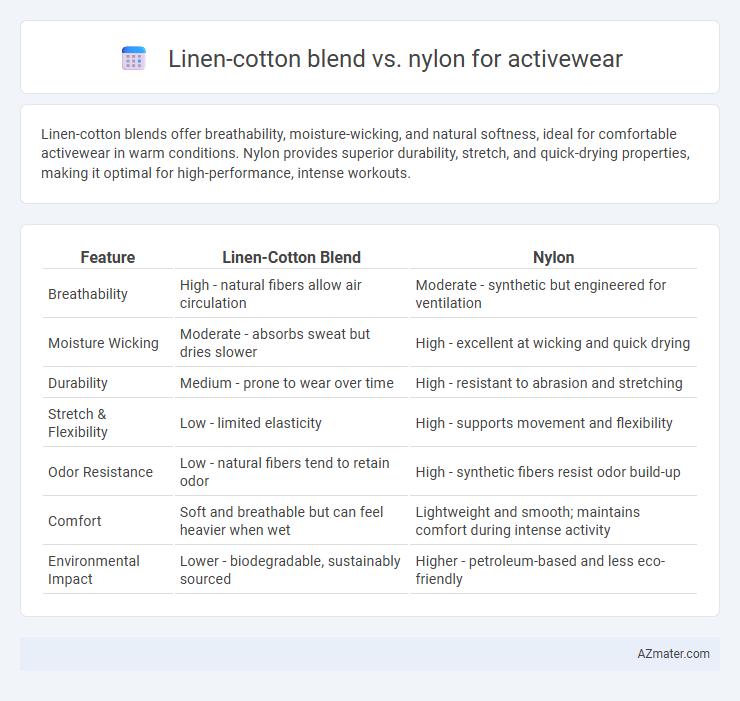Linen-cotton blends offer breathability, moisture-wicking, and natural softness, ideal for comfortable activewear in warm conditions. Nylon provides superior durability, stretch, and quick-drying properties, making it optimal for high-performance, intense workouts.
Table of Comparison
| Feature | Linen-Cotton Blend | Nylon |
|---|---|---|
| Breathability | High - natural fibers allow air circulation | Moderate - synthetic but engineered for ventilation |
| Moisture Wicking | Moderate - absorbs sweat but dries slower | High - excellent at wicking and quick drying |
| Durability | Medium - prone to wear over time | High - resistant to abrasion and stretching |
| Stretch & Flexibility | Low - limited elasticity | High - supports movement and flexibility |
| Odor Resistance | Low - natural fibers tend to retain odor | High - synthetic fibers resist odor build-up |
| Comfort | Soft and breathable but can feel heavier when wet | Lightweight and smooth; maintains comfort during intense activity |
| Environmental Impact | Lower - biodegradable, sustainably sourced | Higher - petroleum-based and less eco-friendly |
Introduction to Activewear Fabric Choices
Linen-cotton blend fabrics offer breathability and natural moisture-wicking properties ideal for activewear in warm climates, providing comfort through enhanced airflow and softness. Nylon excels in durability, moisture management, and elasticity, making it suitable for high-performance activities requiring flexibility and quick drying. Selecting between linen-cotton blends and nylon depends on the activity's intensity, environmental conditions, and desired fabric performance for optimal comfort and functionality.
Overview of Linen-Cotton Blend in Activewear
Linen-cotton blend fabric in activewear offers a natural combination of breathability and moisture-wicking properties, making it ideal for warm-weather workouts and casual athleisure wear. The blend's lightweight texture enhances comfort and airflow, while the cotton content provides softness against the skin and durability for repeated use. Compared to synthetic fibers like nylon, linen-cotton blends emphasize biodegradability and eco-friendliness, appealing to consumers seeking sustainable athletic apparel options.
Overview of Nylon in Activewear
Nylon is a synthetic polymer widely used in activewear due to its exceptional durability, elasticity, and moisture-wicking properties. It offers high resistance to abrasion, quick drying times, and excellent shape retention, making it ideal for high-performance sports and fitness activities. Its lightweight nature and ability to wick sweat away from the body enhance comfort and support during intense physical exertion.
Breathability: Linen-Cotton Blend vs Nylon
Linen-cotton blends offer superior breathability due to the natural fibers' moisture-wicking properties, promoting enhanced airflow and quick drying during physical activity. Nylon, a synthetic fabric, traps heat and moisture more easily, which can lead to discomfort and reduced ventilation in activewear. Choosing linen-cotton blends improves temperature regulation and overall comfort, making them ideal for high-intensity workouts or hot climates.
Moisture-Wicking Capabilities Compared
Linen-cotton blends offer moderate moisture-wicking by absorbing sweat and allowing breathability, making them suitable for light to moderate activities. Nylon excels in moisture-wicking due to its synthetic fibers engineered to pull sweat away from the skin quickly, enhancing drying speed and comfort during intense workouts. Nylon's superior durability and resistance to moisture buildup provide a performance edge over linen-cotton blends in high-sweat scenarios.
Comfort and Feel: Natural vs Synthetic Fabrics
Linen-cotton blends provide superior breathability and softness, making them ideal for activewear that requires natural temperature regulation and moisture absorption. Nylon, a synthetic fabric, excels in durability and moisture-wicking but can feel less breathable and sometimes less comfortable against the skin during prolonged wear. Choosing between linen-cotton blends and nylon depends on prioritizing natural comfort and softness versus enhanced performance and resilience.
Durability and Longevity in Activewear Use
Linen-cotton blends offer moderate durability with natural moisture-wicking and breathability but tend to wear out faster under intense abrasion and frequent washing compared to synthetic fibers. Nylon demonstrates superior durability and longevity in activewear due to its high tensile strength, resistance to stretching and abrasion, and quick-drying properties, making it ideal for rigorous physical activities. Choosing nylon-based activewear ensures extended performance life and resilience against harsh conditions, whereas linen-cotton blends prioritize comfort but require more careful maintenance to prolong usability.
Environmental Impact: Sustainability and Eco-Friendliness
Linen-cotton blends boast superior sustainability due to their natural, biodegradable fibers derived from renewable plant sources, reducing environmental waste and chemical use during production. Nylon, while durable, relies heavily on fossil fuels and produces microplastic pollution, raising concerns over its long-term ecological footprint. Choosing linen-cotton over nylon for activewear supports eco-friendly practices by minimizing carbon emissions and enhancing biodegradability.
Maintenance and Care Requirements
Linen-cotton blends require gentle washing with cold water and mild detergent to maintain fabric softness and prevent shrinkage, while avoiding high heat drying to preserve fiber integrity. Nylon activewear benefits from quick-drying properties and is best cared for with machine washing in cold water and air drying to avoid damage from high temperatures and fabric pilling. Both materials should be kept away from harsh bleach and fabric softeners to extend their lifespan and maintain performance qualities.
Best Uses: When to Choose Linen-Cotton Blend or Nylon
Linen-cotton blend is ideal for activewear in warm, low-intensity activities due to its breathability and natural moisture-wicking properties, making it perfect for yoga or casual sports. Nylon excels in high-intensity workouts requiring durability, elasticity, and superior moisture management, such as running or gym training. Choosing between these fabrics depends on the activity's intensity, climate, and desired comfort level for optimal performance.

Infographic: Linen-cotton blend vs Nylon for Activewear
 azmater.com
azmater.com